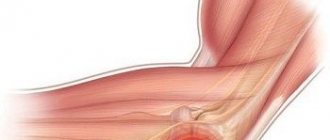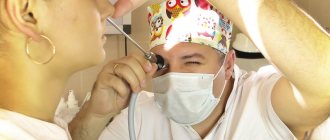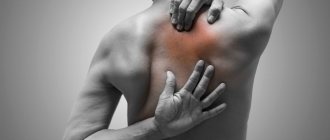Author
: Grachev Ilya Illarionovich
Editor
: Efremov Mikhail Mikhailovich
Date of publication: 05/13/2014 Date of update: 05/05/2021 All doctors of the clinic
- Shoulder pain due to coronavirus and ARVI
- Arthritis
- Diagnostics
A significant proportion of patients complain about pain and limited movement in the shoulder during outpatient visits with an orthopedist-traumatologist, rheumatologist and therapist. What and why it hurts, how to get rid of pain can be found in this article. Do not be afraid, the doctor will eliminate shoulder pain at any stage of the disease.
Qualified specialists can be found in medical, Moscow.
general information
The shoulder joint is one of the most mobile in the body. The head of the humerus is spherical in shape, and the corresponding surface of the scapula is almost flat. The structure is additionally fixed by a strong articular capsule, numerous tendons and ligaments. As a result, a person can move his arm in any direction.
The cause of pain can be any of the elements of the joint apparatus, as well as nearby nerve bundles and muscles. The problem can also come from neighboring structures: the spinal column, heart, stomach, esophagus. Often, only a doctor can accurately determine the cause of pain in the shoulder joint of the arm and prescribe the correct treatment.
Make an appointment
Treatment
Help before diagnosis
In case of traumatic injury, you need to fix your hand with a splint or bandage, apply a heating pad with cold water or an ice pack wrapped in a towel. If there are no wounds or abrasions, chlorethyl can be applied to the skin. For severe pain, you can take an analgesic. Independent attempts at reduction, massage, and active movements of the limb are strictly contraindicated - this can aggravate the injury and complicate further treatment.
For non-traumatic pathologies, rest and elevated position of the limb are recommended. In case of exacerbation of degenerative diseases (tendinosis, arthrosis), an ointment with an analgesic, anti-inflammatory and warming effect is applied to the shoulder joint. The appearance of redness, increasing swelling, severe pain, and signs of general intoxication are indications for immediate consultation with a specialist.
Conservative therapy
The general measure is a protective regime, tailored to the characteristics of the disease. It may include permanent immobilization with a plaster or scarf bandage, temporary wearing of orthoses, and exclusion of all or some types of load on the arm. Unjustified immobility, as well as unjustified overload, harm the joint, so the activity regimen should be determined by a doctor.
For dislocations, reduction is performed, for displaced fractures, reposition is performed. The most common non-drug methods are exercise therapy, massage, and physiotherapy. When treating a joint, a wide range of physiotherapeutic techniques are used, including:
- UHF;
- laser therapy;
- magnetic therapy;
- medicinal electrophoresis;
- galvanization;
- ultrasound;
- shock wave therapy.
According to indications, drug treatment is prescribed - NSAIDs in tablets and injections, chondroprotectors, local agents (ointments, gels, creams, warming patches). In some cases, intra-articular administration of chondroprotectors and hormonal drugs, blockade of soft tissues with glucocorticoids is carried out. For synovitis, therapeutic punctures are performed.
Surgery
Surgical interventions on the shoulder joint are performed using open and arthroscopic approaches and are divided into the following groups, taking into account the type of pathology:
- fresh injuries: osteosynthesis of fragments, open reduction of dislocations, suture of damage to the rotator cuff, resection of the head of the humerus;
- consequences of injuries: derotational osteotomy or strengthening of the capsule in case of habitual dislocations, suturing of a Bankart lesion;
- degenerative diseases: subacromial decompression, removal of intra-articular bodies, tenodesis of the biceps tendon;
- neoplasms: tumor removal, marginal or segmental bone resection, disarticulation of the shoulder joint.
Restriction of movements due to scarring of soft tissues becomes an indication for redressing, due to changes in the articular ends of bones - for arthroplasty, arthrodesis, joint replacement. For malignant tumors, surgical interventions are supplemented with chemotherapy and radiation therapy.
Causes of pain
Pain in the shoulder joint can occur due to various reasons, the most common of which are:
- sedentary lifestyle;
- excess body weight;
- excessive load on the joint apparatus (heavy lifting, vibration, professional sports);
- incorrect posture;
- previous injuries and joint surgeries;
- age over 50 years (tissue regeneration worsens, especially cartilage);
- infectious and autoimmune lesions;
- metabolic disorders;
- disruption of the endocrine glands, as well as sudden hormonal changes (pregnancy, menopause);
- hereditary predisposition to diseases of the musculoskeletal system.
These unfavorable factors cause the development of certain pathologies, which, in turn, cause shoulder pain.
What diseases cause pain in the cervical spine to radiate to the shoulder?
Sometimes the cause of the development of this pain symptom can be quite serious factors of vertebrogenic (associated with pathologies of the spine) and non-vertebrogenic origin. It has been proven that only the “share” of glenohumeral periarthritis and other defects localized in the cervicothoracic spine account for almost 85% of all painful cases with a similar symptom (15% account for arthritis, arthrosis, somatic and oncological diseases).
Thus, if pain in the cervical spine radiates to the shoulder , this may indicate that the patient has:
- arthrosis of the shoulder joint (most typical for middle-aged and elderly people);
- rheumatoid arthritis;
- osteochondrosis;
- intervertebral hernia;
- plexitis;
- humeroscapular periarthritis;
- cervical spondylosis;
- myalgia;
- spinal canal stenosis;
- kyphosis, lordosis or scoliosis;
- shoulder injury;
- dislocated cervical discs;
- inflammation or rupture of tendons;
- dysfunction of the spinal motion segment;
- internal organ diseases (enlarged thyroid gland, meningitis, pneumonia, subarachnoid hemorrhage, etc.);
- infections (poliomyelitis, tuberculosis);
- neoplasms of the neck (organ, extraorgan and metastases).
Possible diseases
Pain in the shoulder joint can be caused by diseases of the musculoskeletal system, nervous and cardiovascular systems, cancer and other processes.
Arthritis
One of the most common causes of shoulder pain. The disease is associated with the development of an active inflammatory process in the shoulder joint, which is accompanied by:
- severe pain syndrome;
- increased temperature and swelling of the affected area;
- redness of the skin over the sore joint.
Pathology occurs against the background of trauma, infectious diseases, hypothermia, high physical activity, allergic and autoimmune reactions. Depending on the duration and severity of symptoms, it can be acute or chronic.
Arthrosis
Arthrosis of the shoulder joint is a chronic degenerative disease in which the gradual destruction of cartilage tissue occurs. As a result, the contacting areas of the bones lose their smoothness. Increased friction during movement causes pain, which gradually increases as the disease progresses. Subsequently, bone growths (osteophytes) form inside the joint cavity, the bones themselves are deformed, and movements are almost completely blocked. In addition to pain, the disease manifests itself as stiffness of the affected joint and a characteristic rough crunch.
Bursitis
Bursitis is an inflammatory disease in which fluid accumulates inside the joint capsule. Most often occurs against the background of trauma. Pathology manifests itself:
- acute pain during movement and less severe at rest;
- increased body temperature (in mild cases, only the area of the affected joint becomes hot);
- pronounced swelling, when pressed on, the movement of fluid inside the limited cavity is clearly felt.
Capsulitis
Chronic inflammation of the capsule surrounding and stabilizing the joint. The second name is “frozen shoulder syndrome”. As a result of a long pathological process, the capsule contracts, and the surrounding ligaments partially atrophy. The pain usually occurs at night, and the disease itself has a wave-like character and either worsens or subsides. After active inflammation subsides, a person feels a pronounced difficulty in movements, especially outward rotation of the arm.
Humeroscapular periatritis
The inflammatory process affects the tissues surrounding the shoulder joint, resulting in severe pain that intensifies with movement. A person cannot raise his arm up and put it behind his back. As the process enters the chronic phase, noticeable stiffness is noted.
Tendinitis
Inflammation of the tendon - tendonitis - occurs against the background of significant physical overload of the shoulder area. Depending on the severity of the pathological process, pain is provoked by physical activity or occurs at rest. The lesion can involve various tendons, which determines the symptoms.
Osteochondrosis of the cervical spine
The disease is associated with flattening of the intervertebral discs, resulting in pinched nerve endings. The intensity of pain depends on the degree of damage, often intensifying when turning and tilting the head. The process may also be accompanied by numbness of the hand and sharp “shots”. Often the pain spreads to other parts of the body.
Ligamentous calcification
The disease is associated with the deposition of calcium salts in the tissues of the ligaments. The exact reasons have not yet been studied. The process causes intense pain during movement and at rest.
Brachial neuritis and brachial plexitis
Damage to the brachial nerve or nerve plexus in this area usually occurs due to injury, hypothermia, or an infectious disease. The pain affects not only the shoulder, but the entire arm, often accompanied by numbness, burning, and the feeling of goosebumps running across the skin. In severe cases, paralysis of individual muscles may develop.
Tumors
Pathological formations in the shoulder area appear quite rarely. As they grow, they compress surrounding tissue. As a result, the patient first experiences discomfort and a sensation of a foreign body in this area, and then pain of varying degrees of intensity.
Diseases of internal organs
Of all the non-musculoskeletal conditions that cause shoulder pain, myocardial infarction is the most dangerous. The pain is usually of a squeezing or burning nature and appears first in the chest area or between the shoulder blades, and then spreads wider, including to the left shoulder, arm, left half of the neck and face. Pathology is usually accompanied by:
- severe weakness;
- sweating;
- dizziness;
- feeling of lack of air;
- fear.
This condition is fatal and requires emergency medical attention.
If the cause of the problem is acute cholecystitis or cholelithiasis, the pain will begin in the solar plexus and radiate to the right shoulder. The attack often occurs against the background of overeating and is accompanied by nausea and vomiting.
Injuries
Bruises, sprains, ruptures and tears of ligaments, joint dislocations, bone fractures inevitably cause acute pain. Depending on the type of lesion, it may be accompanied by:
- limited mobility;
- visual deformation of the joint;
- hematoma formation;
- pathological mobility of bones and crunching of fragments.
The diagnosis is usually not in doubt, since the patient himself clearly associates the occurrence of pain with injury.
Causes of pain in the shoulder joint of the left arm
The shoulder joint is the most mobile joint in the body; improper treatment of the joints leads to injury and the development of degenerative processes in the tissues of the joints and tendons. Pain may appear when the left arm is moved to the side, and intensifies when the arm is raised upward against the background of general well-being. Over time, the pain may intensify or, on the contrary, subside; the phase of joint blocking begins. The patient cannot move his arm, raise or move his arm to the side. With cervical osteochondrosis, severe pain in the left arm can occur due to the formation of an intervertebral hernia. The pain takes over the entire length of the arm when turning the head to the side.
Pain in the arm joint when lifting up often occurs due to calcium deposition - calcification of the articular ligaments occurs. The pain intensifies and becomes constant if there are salt deposits in the tendons under the scapula and collarbone. Movement of the left hand becomes difficult due to calcium deposits, and the patient experiences severe pain. This disorder is often detected in people over 35 years of age during an x-ray. A common occurrence is joint pain in athletes. It is most often felt by heavyweight athletes, bodybuilders, gymnasts, and acrobats. A large load on the ligaments, muscles, and joints leads to various injuries: tendon rupture, muscle tears, and joint capsule stress.
Sharp pain in the left shoulder can be a symptom of a heart attack. Very often, shoulder pain bothers people who perform monotonous work on a conveyor belt, on a machine and other workplaces, when monotonous movements throughout the day are performed with the left or right hand. Pain in the shoulder joint of the left arm may be a symptom of the onset of glenohumeral periarthritis. Humeral periarthritis is characterized by severe pain when rotating the arm, when placing the arm behind the back. Over time, the patient has great difficulty raising his arm up. As his condition worsens, he cannot raise his arm up, has difficulty putting on clothes, or combing his hair.
Arthrosis of the left shoulder joint also causes severe pain in the shoulder; movement of the diseased joint is accompanied by a crunching sound. Arthrosis is most often diagnosed after 40 years of age; the disease affects people who experience great physical exertion and engage in heavy physical labor - blacksmiths, builders, loaders and other specialists. Arthrosis also affects athletes - shot putters, weightlifters, tennis players, athletes whose joints are constantly under heavy load and are exposed to impacts.
Inflammation of the left shoulder joint often develops with rheumatoid arthritis, and very rarely with gout. Arthritis first affects the knee joints, joints of the hands, feet, and lastly the inflammatory process affects the shoulder joints. Another distinctive feature of the disease is the limitation of the joint in the morning; during the day, the stiffness disappears, joint movement is restored, and the pain subsides. Arthritis may be accompanied by fever, chills, and deterioration in general condition.
Nature of pain
Understanding the nature of pain and the ability to describe it will be useful to everyone, since the quality and speed of diagnosis depends on this. Often, just by the characteristics of the sensations, the doctor can assume the presence of one or another pathology. The pain may be:
- acute: occurs abruptly and, often unexpectedly, usually has a shooting character and has high intensity; often occurs against the background of injury, pinching of the intervertebral nerve;
- aching: the intensity of the sensations is low, often they are of a pulling nature; the symptom often accompanies chronic diseases (arthrosis) and inflammatory processes (arthritis, bursitis, glenohumeral periarthritis, etc.) during the recovery period;
- associated with movement: characteristic of most pathologies of the shoulder joint and surrounding muscles; It is important to note which movements cause increased pain, as this helps to make the correct diagnosis;
- reflected: the epicenter of sensations is not located in the shoulder area, a wave of pain also affects this area; the symptom is characteristic of cardiovascular pathology: angina pectoris, myocardial infarction, as well as cholelithiasis, pleurisy, pancreatitis;
- shooting, pulsating: sharp pain impulses are characteristic of damage to the spinal roots, muscle spasms, etc.;
- constant: sensations do not go away either day or night, while movements can intensify them; characteristic of inflammatory processes.
In addition to describing the nature of the pain, it is important to tell the doctor about the accompanying sensations. Thus, nerve damage is often accompanied by burning and tingling, loss of sensitivity, etc.
Why pain occurs, main reasons
The appearance of pain in the shoulder area is not an independent disease, but a clinical manifestation of the influence of a significant number of different provoking factors, which include:
- Aseptic inflammation affecting various structures of the shoulder (nerve fibers, capsule, cartilage tissue of the joint, tendons, muscles).
- Joint infection (bacterial arthritis).
- An autoimmune process that is the result of a violation of the functional state of the immune system, in which antibodies are produced to the body’s own tissues, in particular to the connective tissue structures of the musculoskeletal system with the development of an inflammatory reaction in them.
- Degenerative-dystrophic processes with destruction of cartilaginous structures (arthrosis).
- Systematic significant exposure to physical activity.
- Previous injuries to the shoulder area affecting various structures (dislocation, subluxation, sprain of ligaments, capsules, fracture of the bone base, severe bruise).
Referred pain may also appear, which is the result of the development of a pathological process of another localization in the body (pain in the left shoulder with angina, referred pain with pathology of the cervical spine on the right or left).
Diagnostics
To determine the reason why a person has shoulder pain, the doctor uses the following methods:
- survey: identifying the nature and intensity of pain, the circumstances of its occurrence, the presence of concomitant diseases, etc.;
- examination: the doctor assesses the range of motion in the joint, the color and temperature of the skin, the presence of swelling, limitations in movement, etc.; a neurologist evaluates tissue sensitivity, muscle strength, and quality of reflexes;
- X-ray and CT: pictures and tomograms make it possible to assess the condition of bone tissue and partly cartilage; this is an indispensable method for diagnosing arthrosis, dislocations, cracks and fractures of bones, osteochondrosis of the spine;
- MRI: magnetic resonance imaging allows you to see the condition of not only bones, but also soft tissues, making virtual sections in specified planes;
- Ultrasound: ultrasound examination of the shoulder joint area allows you to see foci of inflammation, accumulation of fluid in the joint capsule, abscesses and neoplasms;
- laboratory diagnostics: a general blood test provides information about the presence of inflammation or allergies; if rheumatoid arthritis is suspected, a test for C-reactive protein, etc. is taken;
- joint puncture: a diagnostic puncture of the joint capsule, through which an analysis of the synovial fluid is taken or arthroscopy is performed (inspection of the joint from the inside using a miniature camera);
- electromyography: assessment of the efficiency of muscle fibers.
If necessary, consultations with narrow specialists and additional examination methods are prescribed: electrocardiogram, ultrasound of the abdominal organs, etc.
Shoulder Pain Treatment
Treatment for shoulder pain depends on its cause. If the problem is related specifically to the musculoskeletal system, painkillers come first:
- non-steroidal anti-inflammatory drugs in the form of injections, tablets and capsules, ointments and creams, patches, rectal suppositories; necessary for quickly stopping the inflammatory process and relieving pain;
- glucocorticosteroids: used in the form of tablets and injections, including for intra-articular administration;
- muscle relaxants: used to relieve muscle spasms in arthrosis, osteochondrosis and other pathologies;
- warming agents in the form of ointments: improve blood circulation in the affected area.
Depending on the cause of the pain, the doctor may prescribe:
- antibiotics (for inflammatory diseases);
- chondroprotectors (for arthrosis);
- B vitamins (for neurological pathologies), etc.
In acute processes and injuries, an important therapeutic factor is hand immobilization. Special bandages and orthoses reduce the range of motion and allow the tissues to fully recover. After active inflammation subsides, a variety of physiotherapy procedures are prescribed:
- magnetic therapy: exposure of the affected area to magnetic waves;
- shock wave therapy: destruction of pathological bone growths by sound waves of a certain length;
- ozone therapy: injection of a special gas mixture into the joint;
- electromyostimulation: exposure of muscles to electrical impulses to cause them to contract;
- ultraphonophoresis and electrophoresis: saturation of tissues with drugs using ultrasound or electric current;
- laser therapy: deep heating of tissues with a laser beam.
These techniques are aimed at improving microcirculation in tissues and stimulating regeneration processes.
Additionally used:
- physical therapy and mechanotherapy;
- massage;
- traction of joints to minimize stress.
If indicated, surgical treatment is used:
- puncture of the joint with removal of pathological contents (fluid, pus, blood);
- restoration of the integrity of bones or ligaments after injury;
- endoprosthetics: replacement of a joint with an artificial one for advanced osteoarthritis;
- removal of tumors.
Make an appointment
Diagnosis and treatment of the disease
The shoulder joint has the most complex anatomical structure among all the joints of the human body. Diagnosis of the disease for pain in the shoulder joint begins with an examination by a doctor, a number of special tests are performed, and the doctor determines external changes in the joint area. Then he prescribes a series of studies:
- Blood chemistry.
- General analysis of urine and blood.
- X-ray of the affected joint.
- MRI – magnetic resonance therapy of the shoulder joint.
- Ultrasound of the joint.
When pain in joints and bones develops, it is important to accurately determine the cause of the disease. The blood is examined for infections, autoimmune diseases, diseases of the digestive tract, and the sugar level is determined. If a malignant tumor is suspected, tumor marker tests are performed. If pain appears after surgery, the doctor prescribes an ultrasound of the shoulder joint and painkillers. Treatment of pain in the left shoulder joint begins with fixing the arm to reduce the load on the joint, tendons, and muscles.
If the pain is caused by muscle spasm, complex treatment is prescribed - muscle relaxants + anti-inflammatory drugs. For joint inflammation, nonsteroidal anti-inflammatory drugs, hormonal therapy, various anti-inflammatory ointments, and gels for external use are prescribed. To reduce pain, relieve inflammation, improve joint condition, and restore motor activity, physiotherapy methods, massage, and special physical therapy exercises are used.
Mud compresses, balneotherapy, ozone therapy, laser therapy, and hydropathy are useful for diseases of the shoulder joint. To find out what disease causes pain in the shoulder joint, you can consult the following doctors: traumatologist, orthopedist, rheumatologist, neurologist. In some cases, consultation with an oncologist is required. Consultations with all these specialists can be obtained at the Yusupov Hospital. In the therapeutic clinic of the Yusupov Hospital you can undergo diagnosis and treatment of diseases of the shoulder joint. You can make an appointment with a doctor by phone.
Possible consequences
The consequences of shoulder pain depend on its cause. Without examination and treatment, damage to the musculoskeletal system and nerves can lead to:
- limited mobility due to arthrosis;
- transition of inflammation to bone tissue (osteomyelitis);
- loss of sensation and motor function;
- severe deformation of a limb, etc.
If a person has a myocardial infarction, cholelithiasis, or pancreatitis, the consequences can be much more serious, including death. It is important to consult a doctor in time, and not use folk remedies.
Possible complications
When a person thinks about why his neck and shoulders hurt, he often decides that the problem is that he has a chilled nerve or pulled a muscle. However, behind this symptom there may be very serious illnesses that will manifest themselves later, but in a more serious form. For example, if this is a manifestation of osteochondrosis, the disease will later manifest itself as severe throbbing pain, lead to hypertension, worsen the performance of the cardiovascular system, negatively affect vision, lead to deafness and lack of coordination in space, as well as a person’s inability to control the movements of the limbs. Clamping of the artery will lead to cerebral ischemia and spinal stroke. Radiculitis will cause problems with blood vessels and the vertebral artery, which can cause a hernia and even death. Every disease is fraught with a lot of complications, so you need to pay attention to the manifestations of diseases in a timely manner and consult a doctor.
Prevention
Prevention of shoulder pain is, first of all, prevention of diseases of the musculoskeletal system. It includes:
- dosed physical activity without striving for records;
- elimination or minimization of occupational hazards;
- wearing the right shoes;
- posture correction;
- sleeping on an orthopedic mattress and orthopedic pillow;
- normalization of body weight;
- proper nutrition with a minimum of harmful foods (alcohol, carbonated drinks, excessively fatty or spicy foods, etc.).
At the first signs of trouble, you must urgently contact a specialist for diagnosis and selection of treatment.
Treatment at the Energy of Health clinic
If your shoulder starts to hurt, the doctors at the Health Energy clinic will always come to the rescue. We offer a full range of examinations to identify the disease, as well as modern comprehensive treatment:
- individual drug regimens;
- drug blockades for quick pain relief;
- physiotherapeutic procedures;
- physiotherapy;
- professional massage;
- therapeutic punctures of the joint capsule with the administration of analgesics or an analogue of synovial fluid;
- PRP therapy.
Advantages of the clinic
“Health Energy” cares about the comfort of each patient. At our orthopedic center, we diagnose and treat specific diseases and problems, and also offer comprehensive screening programs to identify hidden pathologies. Comfortable rooms, experienced staff, appointments by appointment and affordable prices for all services - all this makes taking care of your health truly enjoyable.
Shoulder pain is a symptom that cannot be tolerated. Make an appointment at Health Energy and get rid of your problem!








